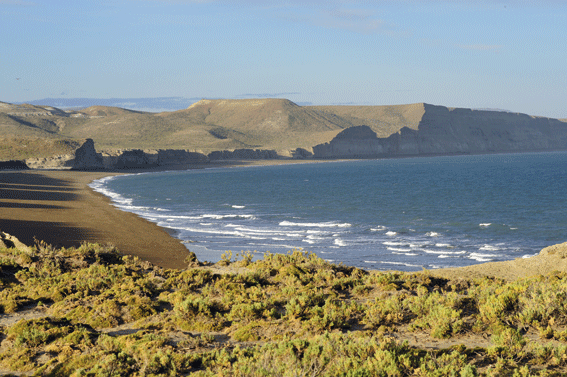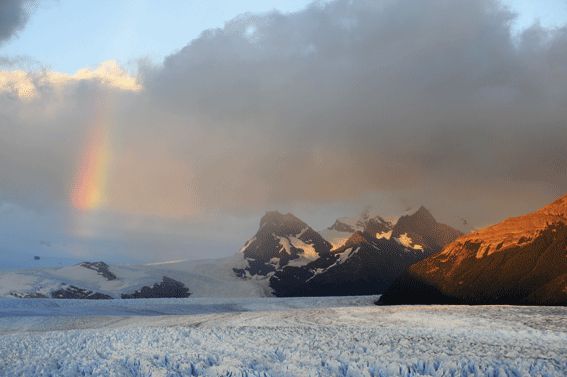
Travel

Argentine Adventure
Argentina, an enchanting dreamland that bewitched my daughter, Chania, who had fallen in love with its infatuating nature and deeply rooted historic features since the first time she set foot in Buenos Aires.
By: Bizzie Frost
Following her advice, and fulfilling a promise we made upon ourselves to her, we decided to pay this beautiful part of the world a visit.
With the aid of “The Rough Guide to Argentina” and the Internet, we spent several months emailing each other to plan a marathon drive that would take us southward from Buenos Aires on a grand tour of Patagonia, ending up in the grape- growing province of Mendoza. Through contacts in Argentina, we were advised to rent a 4x4 sports vehicle, an ideal car with high clearance to deal with some long stretches of “ripio” gravel road in Western Argentina.
We eventually set our departure date on a February day, and flew to Johannesburg on Saudia. Two days later, we caught a fully loaded flight on Malaysian Airlines to Buenos Aires. It was a warm, sunny afternoon when we touched down for the first time in South America.
Buenos Aires is not, at first, an appealing city. It is cluttered with unattractive high rise apartments and the streets are narrow and dark from the huge trees that meet overhead and virtually block out the sky. The City (as is the case with all towns in Argentina) is planned on a grid system and virtually all streets are one-way only. This means that they are also very busy and noisy with heavy traffic. I have never seen so many buses anywhere, and the City has an excellent and very cheap public transport system, including trains and an underground network. Taxis are also plentiful and cheap.
We soon learned that it is never too late to go out in Buenos Aires – or anywhere in Argentina. Restaurants are relatively empty up to about 9 pm; by midnight, they are full. The City is friendly and sociable, and in the summer evenings, tables outside restaurants in the “plazas” are full of people sitting, chatting for hours, sharing pizzas, or large platters of cheese & salami, and enormous liter bottles of local drinks.
With plans to spend a few days in Buenos Aires at the end of our trip, after only two nights, we set off with our son & daughter to Bahia Bustamante, an “estancia” (ranch) 1700 kms away on the Atlantic coast. Chania had worked there for 3 months as a volunteer tour guide and so knew it well. We followed the RN3, a good paved road that runs all the way down eastern Argentina, and stopped for a night at Carmen de Pategones. The Argentines greet each other with a kiss on one cheek and as we went into a local shop that sold everything from Panadol to Gaucho knives. The town was full of very old, beat-up cars with noisy exhausts that could be heard late into the Friday night, roaring up and down the street past our hotel. It seems that Argentina puts a heavy tax on new cars, so 40-year-old vehicles rattle down the town streets and country highways, often badly dented with patchwork paint schemes and with lights missing, but nonetheless still moving.
Although Argentina is an oil rich country and has its own refineries, it has relatively few fuel stations along its remote highways. We were advised to refuel at every station that we passed because it is a common phenomenon to arrive at one only to find their tanks are empty.
Bahia Bustamante is a ranch of 85,000 hectares of wilderness on the Atlantic coast and to reach the settlement of houses on the beach, you drive 35 kms from the main road – and all of it is through the Bustamante land. It is the ultimate escape from the hustle and bustle of modern living: there is not an electricity or telephone pylon in sight, and you can switch off your mobile phone as there is no signal.
Only the estancia office has a radio telephone. There is no TV either and no daily papers. Electricity comes from a generator which comes on at around 7 pm and goes off again at midnight. During that time, computers can get a signal and email is available.
Originally set up as a seaweed harvesting ranch, Bustamante also has sheep and guanacos (rather like Llamas) and more recently, has turned to tourism. Activities include hiking, swimming, horse riding, mountain biking, visits to the 65 million year old petrified forest, boat and kayak trips to see the huge colonies of sea lions, cormorants, Magellan penguins and other marine birds, and visits to the seaweed warehouse. During the season, visitors can also see the “gauchos” (cowboys) at work rounding up the sheep on horseback, then shearing and marking them. Virtually all food is organic and comes from the ranch, including lamb and guanaco meat, chicken, eggs, vegetables and fruit.
From Bustamante, we headed to the far south of Patagonia, stopping for a night at the Monte Leon National Reserve, a wilderness with miles of unspoiled beach and rugged cliffs facing the wind and waves of the South Atlantic Ocean. By the time we headed inland towards El Calafate, we were getting used to traveling hundreds of kilometers in a day and enjoyed the mentally cleansing effect of being surrounded by the vast, empty landscape and sky. The only sign of humanity was the neat ranch fencing that faithfully followed the road throughout Patagonia. Occasionally, a herd of horses or guanacos could be seen in the distance, or a small flock of “choiques”, birds that look like miniature ostriches. There was no litter anywhere – even in the towns.
El Calafate is famous for its glaciers which come off the Andes mountains into Lake Argentino. We rose before dawn and arrived at the Perito Moreno glacier to see the sunrise painting the surrounding hills with light. In the chilly air of the morning, we listened to the massive wall of ice creak, groan, crack, and finally make explosive “booms” as huge chunks fell off and landed in the lake. We took an hour long boat trip to get a closer view, and then returned to the boardwalk and viewing platforms where we spent several hours, mesmerized by the sounds of the constantly shifting ice, hoping to see a really big bit fall off.
From El Calafate, we joined “La Cuarenta”, the famous RN-40 that runs all the way up the western side of Argentina. Much of this road is gravel, which for the uninitiated can make for difficult driving. Having spent years in Kenya, we felt thoroughly at home and enjoyed the sensation of really being “on safari”. Days and days on roads cutting through huge expanses of scrub desert followed, and we loved all of it. The immaculate fences continued, and we reveled in the lack of ribbon development and any signs of humanity. We took bets on how many cars we would pass between towns – and some of the “towns” marked on the map turned out to be nothing more than a petrol station with a few pumps, and a convenience store that also served as the local café and hotel. One “town”, Los Monos, turned out to be a roofless, derelict building at a road junction.
At Esquel, we took an afternoon trip on “La Trochita”, the old Patagonian steam train that runs on a narrow 75 cm gauge track through the Estancia Leleque, owned by an Italian clothes entrepreneur. Continuing northwards, we stopped for a few nights in San Carlos de Bariloche on Lake Nahuel Huapi in the Andes foothills; it is Argentina’s top ski resort, as well as being a popular summer resort. Our visit coincided with wet, cloudy weather, so activities to view the lakes and mountain scenery were pointless. We opted instead for “Canopy”, a forest experience which gets the adrenalin flowing as you speed between high platforms along steel cables connected to huge trees.
Our final destination before returning to Buenos Aires was Mendoza at the heart of the grape growing province. We visited two superb vineyards, one ultra modern, the other a contrasting traditional one which doubled up as a museum, housing masses of antique equipment, enormous old French oak barrels, and an assortment of vintage wagons and vehicles. In the town, we enjoyed an evening of operatic entertainment as the Italian community, descendants of the early Italian immigrants, opened the annual Mendoza Festival, giving thanks for the grape harvest.
We had two final missions before leaving Argentina: one was to see some Tango dancing, the other was to see a football match at the yellow and blue Boca Stadium. Diego Maradona himself was watching the match, but we were seated near the Boca Junior fans and found it more fun to watch the antics of the notorious fans than the game. They fill one entire end of the stadium, have a brass band and huge drums, and from start to finish, they sing loudly and enthusiastically. When the action gets hot, the singing and cheering reaches a crescendo, and they jump up and down in unison, shaking the stadium.
Our trip to Argentina was just under four weeks. During twenty of those days we drove 8,500 kms. We had still seen only half of the country. If you were to fly, you would get around more quickly, but you couldn’t appreciate the huge size, isolation and beauty of Patagonia. The accommodation in the towns caters to all budgets, from cheap dormitories in hostels to exotic 5 or 6 star hotels, or you can get away to remote and very comfortable estancias. You can travel throughout on coaches with sleeper seats, rent a car, fly, or go by motorbike – or even cycle. No matter how you choose to see Argentina, you can be sure of one thing: a warm welcome from very hospitable people.